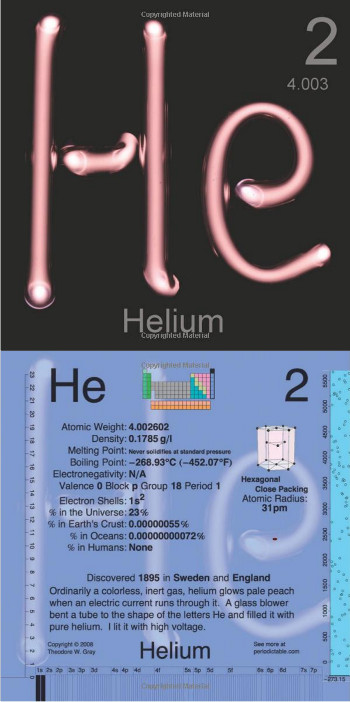In my last blog post, I set the groundwork for Periodic Table Rummy, a simple card game to help students understand the periodicity of the periodic table of the elements. I decided to use Theo Gray’s The Photographic Card Deck of the Elements as my “standard” deck of cards for the game. The game plays like rummy, with some additions of my own to keep the focus on categorization.
 Helium as seen in Theo Gray’s The Photographic
Card Deck of the Elements. The top picture is top of the card, and the bottom picture is the "face" side of the
card.
Helium as seen in Theo Gray’s The Photographic
Card Deck of the Elements. The top picture is top of the card, and the bottom picture is the "face" side of the
card.
Here are the basic rules:
- Shuffle the deck (picture side up) of 118 elements and deal 10 cards to each player.
- Place the deck picture side up in the center of the playing field. Turn the first card over to form a discard pile.
- Play begins to the left of the dealer. On a player’s turn, they have two choices: pick up a card from the discard pile or pick up a card from the top of the deck. A player always draws a card to start their turn. They will then discard a card from their hand. If they draw from the discard pile, they must discard a different card.
- After their normal draw and discard, a player may lay down 5–9 cards in front of them that meet one of
two criteria:
a) Cards in the same group of the periodic table that all have matching card background colors.b) Cards with consecutive atomic numbers.Cards show the location of the element on the periodic table.
- After laying down a set of cards, a player must:
a) Read the entry for the “fact sheet” of the group of the elements being laid down, or the periodicity “fact sheet” if laying down consecutive numbers andb) A fun or interesting fact of one element laid down.If a player fails to read the information and the other players catch them, they must shuffle all their cards back into the deck and draw ten new cards!
- After playing 5-9 cards and successfully reading them, a player redraws from the deck to make a hand of 10.
Winning
A player that has successfully laid down groups totaling 15 or more individual cards wins the game! Other players can continue to play for second and third place.
The “fact sheets” are important supplements to the game because they keep the focus on the grouping of elements and the common properties each group has. Each fact sheet has a picture highlighting the position of the category on the periodic table as well as some key properties. An example of fact sheet text: “The alkali metals are all soft metals that can be cut with a knife. They react with water and air with increasing ferocity as you go down the table. Lithium fizzes in water while Potassium produces a popping flame. Both the fizzing and popping explosions are produced by explosive hydrogen gas being ignited in the reaction. The alkali metals are critical elements for transmitting signals in our nervous systems.”
What I find to be most important about this game is that it is simple, quick to learn and play, and is focused on the real learning about the periodic table that science educators need students to understand. It could work for any content area! Any deck of cards that functions to categorize things could be used as the card for this game. How might you use this basic framework to bring a version of rummy to your classroom?

Comments
Periodic Table Rummy
Hi - this is so cool! Will there ever be a Demo game at Spielbound of it?